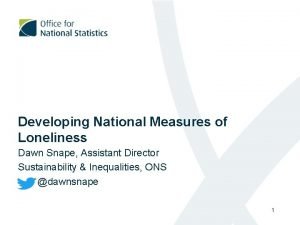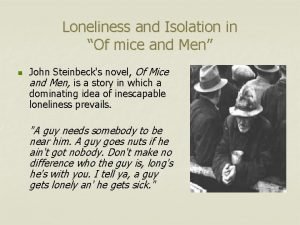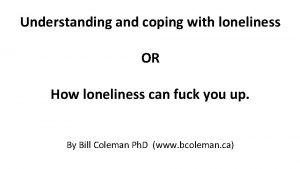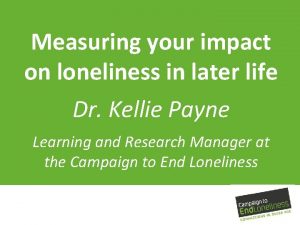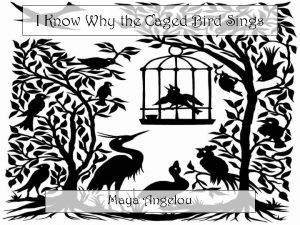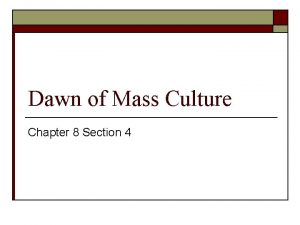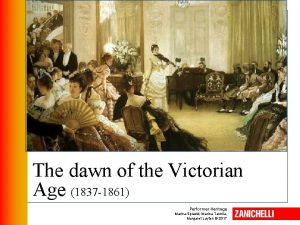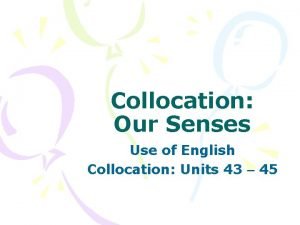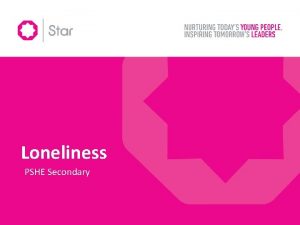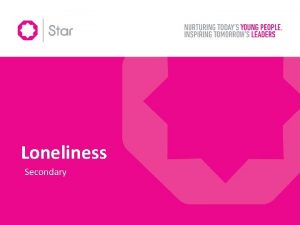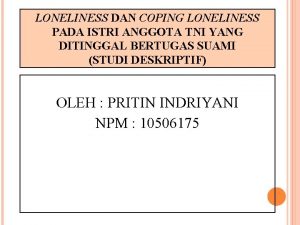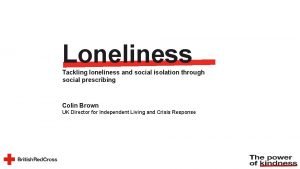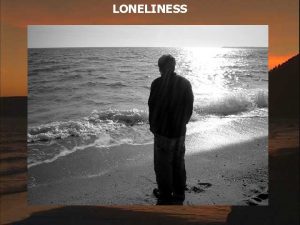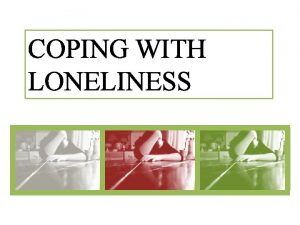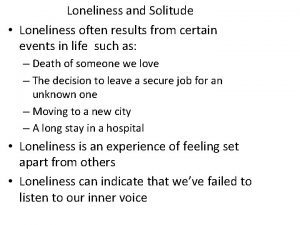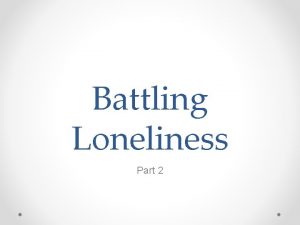Developing National Measures of Loneliness Dawn Snape Assistant

















- Slides: 17

Developing National Measures of Loneliness Dawn Snape, Assistant Director Sustainability & Inequalities, ONS @dawnsnape 1

The Challenge “Establishing appropriate indicators of loneliness across all ages with the Office for National Statistics so these figures can be included in major research studies” (Theresa May, January 2018) 2

First principles • What do we mean by ‘loneliness’? • Why are national measures needed? • What exists now? • How will the measures be used? • From what age can we ask about loneliness? 3

Why do we need loneliness indicators? • Widely varying estimates of the ‘loneliness epidemic’ • Patchy evidence • Conceptually muddy • Inconsistent measurement: • • Multiple measures Used differently Interpreted differently Samples may not be representative 4

How will national indicators help? • Conceptual clarity • Consistency & comparability • Extending the focus to ‘all ages’ • Building evidence of ‘what works’ more effectively • Monitoring & benchmarking Better data Better evidence Better decisions 5

Approach taken to national indicators Step 1 Step 2 Step 3 • Convene experts (academics, third sector, government analysts and policy leads) • Discuss options & consider what exists now • Agree loneliness definition • Agree key criteria for the measure(s) • Scope possible measures & test options • Make recommendations based on testing results 6

What progress so far? ü Working definition aligned with Jo Cox Commission ü Key measurement criteria agreed • Avoid stigma/ harm • Build on what exists • Brevity/ flexibility ü Scoping work done ü Survey & cognitive testing underway 7

‘Loneliness’ versus ‘social isolation’ “Loneliness is a subjective, unwelcome feeling of lack or loss of companionship. It happens when we have a mismatch between the quantity and quality of social relationships that we have, and those we want. ” (Jo Cox Commission) “Social isolation is an objective measure of the number of contacts that people have. It is about the quantity and not quality of relationships. People may choose to have a small number of contacts. ” (Care Connect) 8

Why does it matter? • We need to define and measure what we want to improve • Perceived quality/ expectations of relationships may vary between groups • Need to tailor interventions accordingly “Bringing people together to increase the number of social contacts is not an end in itself – to combat loneliness, the quality of relationships needs to be addressed. ” (Care Connect) 9

Early work to inform policy • Characteristics/ circumstances of those most frequently lonely (aged 16+) • Qualitative research with children & young people • What Works Wellbeing reviews of interventions 10

Who is most frequently lonely? Latest from Community Life Survey (2017 -18): - 6% of respondents felt lonely ‘often’ or ‘always’ - 13% of those with long term illness/ disability were lonely often or always (3% of those without) - Younger people aged 16 -24 and 25 -34 were lonely often or always (both 8%) compared to 3% of those aged 65 -74 and aged 75 and over. - People living in urban areas (6% often or always) compared to 3% of those in rural areas - People living in most deprived areas (8% often or always) compared to least deprived areas (4%) 11

And some other estimates of loneliness among older people • 9% aged 52+ said they felt lonely ‘often’ (ELSA, 200910) • 14. 5% aged 65 -79 scored their level of loneliness in daily life as 6 or more out of 10 (ONS, OPN) • 11% of people aged 65 -74 felt lonely ‘often or always’, 10% for those 75+ (National Survey for Wales, 2016 -17) 12

Key findings on loneliness ONS latent class analysismost at risk of frequent loneliness: • Widowed older homeowners living alone with long-term health conditions. • Unmarried, middle-agers with long-term health conditions. • Younger renters with little trust and sense of belonging to their area. 13

What next? • As well as policy announcements… • What Works Wellbeing to publish evidence review • ONS to publish recommended measures, testing results and guidelines (November) • Publication of analysis of loneliness among children and young people in collaboration with Children’s Society • ONS is progressing two new collaborative initiatives: Centre for Ageing and Demography and Centre for Inequalities 14

ONS Centre on Ageing and Demography • Inform public debate, improve public understanding, and make people take notice of the impacts of ageing and demographic change • Inform decision makers so that public policy is based on the best evidence about ageing and understand its impact. • Anticipate and respond quickly to emerging issues, policy needs, economically and socially • Make better use of data sources within ONS, across government and beyond; and develop new data sources • Improve coherence and communication of information and analysis • Form partnerships with others in GSS and beyond (academics & other third parties) 15

Centre for Inequalities • Similar aims, but with a focus on improving data, analysis and methods to understand inequalities in the UK more effectively. • Collaborative, convening centre- ONS, central government, local government, academia, 3 rd sector • Aligned with EHRC approach & focusing on: • 9 protected characteristics of the Equality Act (2010), across 6 key areas of life, human rights based methods • Deeper analysis of cross-cutting issues (eg, social mobility, inter-generational fairness, inclusive growth, etc) • Aim of making inequalities focus at ONS sharper, more coherent, more accessible 16

@dawnsnape Thank you! 17
 Dawn snape
Dawn snape Rebecca snape
Rebecca snape Wiggles exhibition
Wiggles exhibition Anova repeated measures
Anova repeated measures Loneliness and isolation in of mice and men
Loneliness and isolation in of mice and men Loneliness imagery
Loneliness imagery Greek mythology loneliness
Greek mythology loneliness Loneliness frankenstein
Loneliness frankenstein Coping with gay loneliness
Coping with gay loneliness Figurative language in of mice and men chapter 1
Figurative language in of mice and men chapter 1 Go placidly
Go placidly Loneliness measurement tool
Loneliness measurement tool Wazn music
Wazn music Dawn meyerriecks
Dawn meyerriecks The fat worms waiting on a dawn-bright lawn
The fat worms waiting on a dawn-bright lawn The dawn of mass culture section 4
The dawn of mass culture section 4 Senior citizen age
Senior citizen age Smell collocation
Smell collocation
